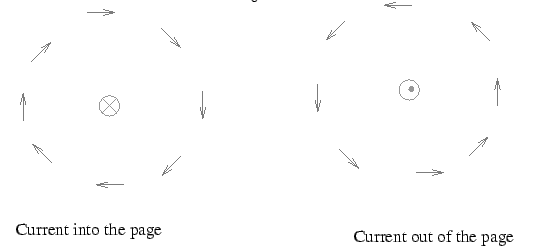SKEDSOFT
Magnetic Field: Electric charges are source of electric fields. An electric field exerts force on an electric charge, whether the charge happens to be moving or at rest.
One could similarly think of a magnetic charge as being the source of a magnetic field. However, isolated magnetic charge ( or magnetic monopoles) have never been found to exist. Magnetic poles always occur in pairs ( dipoles) - a north pole and a south pole. Thus, the region around a bar magnet is a magnetic field. What characterizes a magnetic field is the qualitative nature of the force that it exerts on an electric charge. The field does not exert any force on a static charge. However, if the charge happens to be moving (excepting in a direction parallel to the direction of the field) it experiences a force in the magnetic field.
It is not necessary to invoke the presence of magnetic poles to discuss the source of magnetic field. Experiments by Oersted showed that a magnetic needle gets deflected in the region around a current carrying conductor. The direction of deflection is shown in the figure below.

Thus a current carrying conductor is the source of a magnetic field. In fact, a magnetic dipole can be considered as a closed current loop.
Electric Current and Current Density: Electric current is the rate of flow of charges in electrical conductor. In a conductor the charges may have random motion. However, the net drift velocity of the charges is zero, giving a zero net current. In the presence of an external force field, the charges move with a net non-zero drift velocity, which gives a current.
The direction of current has been defined, conventionally, as the direction in which the positive charges move. In case of metallic conductors, the current is caused by flow of negatively charged electrons, whose direction of motion is opposite to the direction of current. In electrolytes, however, the current is due to flow of both positive and negative ions.
The current density ![]() at a position
at a position ![]() is defined as the amount of charge crossing a unit cross-sectional area per unit time. In terms of the net drift velocity of the charges (taken opposite to the net drift velocity of electrons),
is defined as the amount of charge crossing a unit cross-sectional area per unit time. In terms of the net drift velocity of the charges (taken opposite to the net drift velocity of electrons), ![]() ,
,
The unit of electric current is Ampere (= coulomb/sec) and that of the current density is A/m ![]() . For a thin wire with a small cross sectional area, the current density
. For a thin wire with a small cross sectional area, the current density ![]() may be taken as uniform. In this case,
may be taken as uniform. In this case,
![]()
where ![]() is the component of the area vector parallel to the direction of current.
is the component of the area vector parallel to the direction of current.
The Right Hand Rule:
The direction of magnetic field due to a current carrying conductor is given by the right hand rule.
|
If one clasps the conductor with one's right hand in such a way that the thumb points in the direction of the current (i.e. in the direction opposite to the direction of electron flow) then, the direction in which the fingers curl gives the direction of the magnetic field due to such a conductor. |
